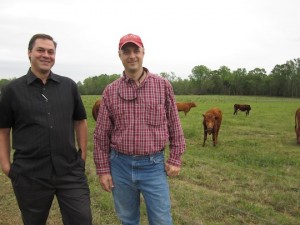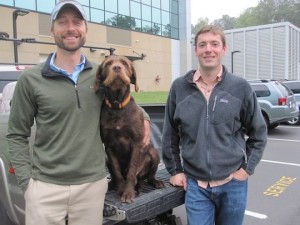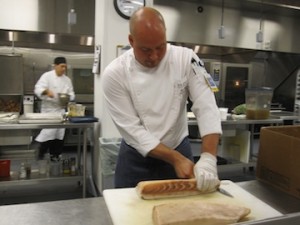Fast vs. Slow Food: Two North Carolina Farm to Fork Vendors
Recently I met two very different Farm to Fork suppliers for Bon Appétit accounts in North Carolina — about as different as you’d expect a fish distributor and a beef rancher to be. Yet they had one key thing in common that made partnerships with our teams work.
At 7 a.m. on a Wednesday, Ryan Speckman and Lin Peterson pulled up in their pick-up truck to drop off about 50 pounds of swordfish to SAS headquarters in Cary, NC. The founders and operators of Locals Seafood, a small, Raleigh-based company, aren’t your average fishermen. In fact, they aren’t fishermen at all – they both have degrees in fisheries and wildlife science.
While working with endangered species on the North Carolina coast as a biologist, Ryan developed friendships with many of the local fishermen. He came to understand their challenges while simultaneously recognizing how difficult it was to get fresh seafood caught on the North Carolina coast to central North Carolina (the area known as the “triangle”).
The fishermen used to joke with him that he should just fill up his truck and drive their fish to Raleigh to sell it for them. So when the project he was working on came to a close, he decided to give being a seafood distributor a try. For him and his business partner, Lin, it was about a fresher product and, just as importantly, a way to help out the struggling coastal economy. They now work with roughly 12 fishermen.
Locals Seafood has been supplying fresh fillets and shellfish to the café at SAS for about 6 months now. When I asked Lin about his experience with Bon Appétit chefs – which aspects had been helpful, which challenging – he thought for a moment before answering. The bulk of Locals Seafood’s business right now is a walk-up stand at farmers’ markets. Having customers, such as chefs, who buy in larger volumes is a crucial step towards growing the business and being profitable. But most chefs, he said, are accustomed to looking at an order sheet of options and choosing from the list a week or two in advance.
When you’re buying fresh fish from only small-scale fishermen, that just isn’t an option. There is little certainty about what kind of fish and how much each fisherman will catch ahead of time, and once seafood is caught, it needs to be sold and served immediately. Executive Chef Eric Foster, however, is willing to work within the small windows of opportunity available. Ryan will text Eric while standing on a boat docked at the pier — “Hey, we’ve got 60 pounds of flounder. Want it?” — and can count on Eric’s quick response.
Eric, for his part, can incorporate the freshest catch into the current or next day’s menu. Like all Bon Appétit cafés — but unlike the vast majority of the food service industry — the café at SAS doesn’t operate with a “menu cycle,” or a companywide recipe schedule. Eric and his team write and print their own new menus weekly, and can thus be flexible about last-minute modifications.
So for SAS and Locals Seafood, real-time communication is critical. But another Farm to Fork – Bon Appétit relationship depends on a very different timeline.

Regional District Manager Michael Aquaro with Patrick Robinette, owner and operator of Harris Robinette Farm
Patrick Robinette runs a small (350 acres) pasture-based cattle operation that supplies beef to Bon Appétit cafés at Duke University.
When I asked Patrick the same question about what made this partnership work, I got the opposite answer. His relationship with Bon Appétit has been beneficial because of the commitment Duke University is willing to make in advance. A grass-fed steer takes three years to go from birth to beef. Patrick had to say that at least twice before it sunk in: that means, in order for Duke students to have grass-fed beef in their burritos in 2015, Patrick needs to start breeding his heifers now.
Each café Patrick sells to communicates with him differently. At Duke, chefs use the summer to project beef purchases for the year, so that Patrick is able to plan ahead. In addition to allowing him to plan for the busy times, Patrick is able to prepare for times when the university is closed for breaks. Although there is no guarantee, the Bon Appétit team at Duke provides the projection as a courtesy to him and commits to doing their best to stick to it.
Patrick’s relationship with Bon Appéit’s Michael Aquaro is central to this success. They first met seven years ago, when Michael was the executive chef at Duke University. Now, in his position as regional district manager of the southeast, Michael has an understanding of the needs of the region and the ability to connect Patrick with a growing market. Michael now sits on the farm’s board of directors, and helps provide a sense of the current demand in the region and growth opportunities for the years ahead.
It is the stark contrast between the two scenarios that I find most interesting. For small-scale fishermen, you need real-time communication. For local, pasture-raised beef, you need commitments years in advance. The connection between these two ends of the spectrum? They are both unconventional timelines for wholesale buyers. They require flexibility and an acceptance that fresher, more sustainable food often comes through nontraditional channels, and that sometimes we need to shift away from the accepted mentality in order to make those channels viable.
At Bon Appétit, our Farm to Fork program started in the 1990s, when our chefs’ went looking for better flavor in their ingredients. As it grew, so did our understanding of how working directly with farmers could support healthy rural communities and a more sustainable food supply. “Vote with your forks” is a popular saying these days in the good-food movement. At a large company like Bon Appétit, a lot of people go out of their way every day to make that vote possible.

